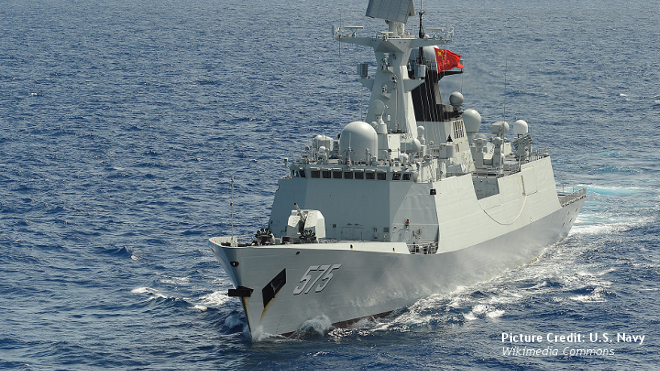China’s Mixed Message in the Baltic?

Last month’s joint military training exercise between Russia and China in the Baltic prompted much discussion on the nature of Sino-Russian relations in the post-Crimea annexation era. Moreover, it also marked the first time the Chinese navy, the PLA-N, has deployed in the Baltic Sea.
The presence of Chinese warships was looked upon with a degree of trepidation by governments in the region, with the Swedish Prime Minister publicly stating a desire to take the issue up with Chinese officials and Lithuania’s foreign minister warning that the presence of the PLA-N could lead to increased tensions.
A major naval drill by the world’s second and third-largest military powers nearby was bound to induce a degree of anxiety. The three Baltic States in particular (Estonia, Latvia, Lithuania) have historical experience of suffering from the collusion of great powers and consider Russia a significant security threat.
Joint Sea 2017
Russia and China have held annual military drills every year since 2012, including in politically sensitive areas such as the South China Sea. This year’s drill “Joint Sea 2017” began in the Baltic Sea (July 21-28), taking place mainly off the coast of Kaliningrad – an area of strategic importance for Russia – and will be followed by a series of exercises in the Sea of Japan and Okhotsk in September.
As stated in the Russian media, the drill consisted of two stages – a coastal and an active seas stage. During the drill, the Chinese ships were stationed in the Baltiysk port in the Russian exclave of Kaliningrad. The scenarios appeared to focus on search and rescue missions, as well as anti-piracy activities, but also covered firing exercises. Xinhua news reported that the exercises included “ship-to-sea firing by secondary guns, air defense, landing and inspection, maritime search and rescue, dry cargo replenishment and shipwreck relief.” After the drill, the Chinese ships headed to St. Petersburg to attend Russia’s Navy Day celebrations on July 30.
According to the People’s Daily, the Baltic drill’s aim was to strengthen the comprehensive strategic partnership of coordination between the two countries and was not aimed at any third party.
In recent years, China has sought to boost its naval strength in a bid to improve the country’s strategic and economic position. The drill in the Baltic came on the heels of China opening its first overseas military base in Djibouti and the launch of the Liaoning aircraft carrier in April.
The drill furthermore served the purpose of demonstrating to both domestic and foreign audiences that Chinese naval forces are capable of manoeuvring in faraway seas. China’s naval presence at the port of Kaliningrad can also be interpreted as an exercise in freedom of navigation, a major point of contention with the U.S. in the South China Sea.
China’s participation in the drill, while closely followed, did not elicit strong objection which illustrates that China – geographically distant – is not perceived as a security threat by the three Baltic States. This contrasts with the much more apprehensive mood regarding the upcoming Russian-Belarusian military exercise “Zapad 2017” which will also be held in the vicinity of Kaliningrad, has been estimated to be the largest Russian exercise since the end of the cold war and is speculated to enact scenarios aimed at closing the strategically vital Suwalki gap.
Unlike Moscow, Beijing has remained committed to non-interventionism and it is difficult to imagine that China would have any military ambitions in the region.
Relations between China and the Baltic States are good and cooperation is steadily deepening. In 2016, all three countries celebrated the 25th anniversary of the establishment of diplomatic relations with the PRC, and are eager for enhanced economic cooperation.
At the 5th China and Central and Eastern Europe summit (16+1 framework) in November 2016, the so-called Riga declaration was signed with the aim of enhancing “cooperation in the development of ports, transport corridors and infrastructure connecting the Central and Eastern European countries with China.”
Thus, any conflict or tensions in the Baltic Sea hardly fits with Xi Jinping’s Belt and Road Initiative, which emphasizes win-win cooperation and peaceful development. After all, the EU is China’s biggest trading partner, and China is keen on promoting cooperation with countries surrounding the Baltic Sea, with high level visits to Finland and Estonia in the past year.
Mixed Messages?
But while from a Chinese perspective there is no reason why joint drills with Russia should hamper cooperation and good relations with other European states, China’s involvement with Russia could be interpreted as sending a “mixed message” to the Baltic States.
Russia’s war with Georgia in 2008, the annexation of Crimea in 2014, and the propping up of puppet regimes in Donbass and Luhansk have been worrisome developments for the Baltic States which, much to Moscow’s consternation, have become full-fledged members of NATO and the EU.
For Russia, therefore, the Joint Sea 2017 exercises were one of many shows of strength with the purpose of sending a signal not only to the Baltics but also NATO, which has increased its presence in Poland and the Baltic States.
The statements from the Swedish and Lithuanian ministers should therefore function as a reminder to China. Heightened tensions between Russia and NATO in the wake of the annexation of Crimea in 2014 have drawn more scrutiny toward the Baltic Sea and the appearance of Chinese vessels there may lead some observers to connect China with the Kremlin’s military provocations. China needs to consider regional implications and should be careful not to be caught up in a message not its own.